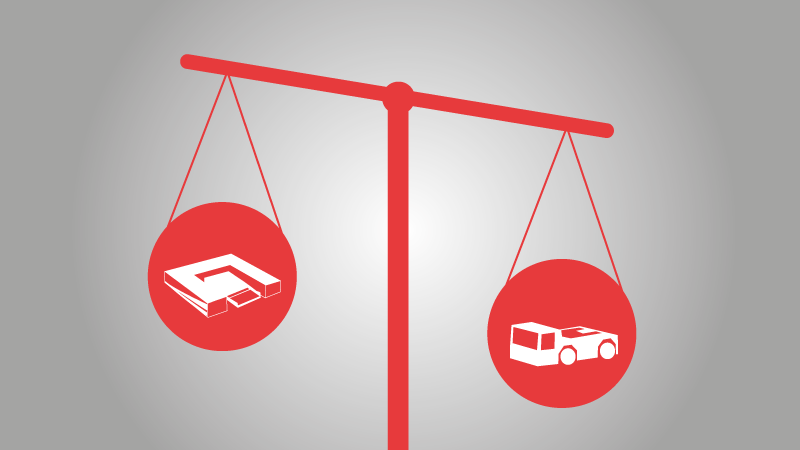Clients often ask us: “Mototoks are so light. Isn’t that bad? Is this an advantage? Are they even heavy enough to tow a heavy plane?” Well, first of all: Yes, they are. And for the other questions – let’s have a closer look at an aircraft tug’s weight and what is important about it.
We would love to give you an equation that goes like “heavier = better” but – as often – it’s not that easy. To understand why a tug’s weight is an important factor we need to get into some technical details.
Weight distribution and how to get an airplane moving
The nose gear usually carries up to a maximum of 15 % of the plane’s weight. If we take a Boeing 737-900 as an example this means up to 11,850 kg (26,124 lbs). If you want to move this airplane, this is about the weight your tug needs to have in order to overcome the friction. Otherwise, the weight of the nose gear is going to prevent the tug from moving. At this point you have two possibilities: Either you have a tug that is actually that heavy, or you cheat.
1. Heavy aircraft tug: The “tug of war” principle
When the aircraft is standing on the ground, the gravity is pulling it towards the ground – this is the power you are competing with. If you will try to tow a 100,000 t plane with a tricycle you will notice that either the wheels of your tricycle will start to spin at some point, or you simply won’t be able to pedal. So unless you have incredibly high torque you will need a heavier ride.
If your tug’s weight is five-digit you are more likely to succeed. The tug can counterpose the nose gear’s weight so while gravity is pulling the aircraft down the tug is pulling sideways. It is like a game of tug of war (pun intended) between the tug and the aircraft. How heavy the tug has to be depends on the aircraft’s weight. The heaviest tugs are required when using a tow bar since the whole tug has to come up with the weight itself – in contrast to the second method.
2. Light aircraft tug: The clever cheating principle
Don’t worry, this method is nothing illegal but simply an intelligent and efficient way to move an aircraft. If you have been paying close attention you probably can already guess where this is going. The weight your tug needs to have to move the aircraft is about the weight of the nose gear. So wouldn’t it be easiest to simply pick up the nose wheel and be done with it? Exactly. If the tug picks up the nose gear completely and places it atop of itself it automatically weighs as much as the nose gear plus its own initial weight. Thus even a light tug can get enough grip to tow a plane.
By the way: This is the principle our Mototoks are using. They are relatively light (between 850 kg and 5 t) but they can pick up the wheel hydraulically, gaining enough weight to move the whole plane around. Take a look at our product pages for more information.
Light and heavy – advantages and disadvantages
So as we learned, both heavy and light aircraft tugs can do the job. But there are some up- and downsides to a tug’s weight.
A heavy tug is easy to set in motion but quite difficult to bring to a standstill since you have to brake the tug’s own weight as well. This requires very good brakes and causes massive attrition – even when the tug is moving without any load. In addition these heavy tugs need a lot of energy (fuel) to move, making them an economical and ecological disaster.
The parts of light tugs don’t wear out as quickly and their lower overall weight requires less energy to move them. Lower maintenance and operating costs make them efficient and saving. But if you go with a light tug you need to make sure that it is well equipped.
For instance, in frosty conditions, heavy weight gives additional grip on the slippery ground. Light tugs have to compensate this – such as with clever tires. That’s why for example our Mototoks use special PU-tires. They are made of solid plastic so there is no air inside that could deform the tire. Moreover, the area of contact is very small so the contact pressure is much higher – this gives extra grip and stability.
Conclusion to the weight of aircraft tugs
The weight is an important factor when it comes to aircraft tugs. In order to move an airplane, tugs have to be very heavy, although they can cheat themselves into heaviness. From an economic point of view, light tugs are much more cost-efficient, but they need to be well equipped.
If you want to learn more about this topic, contact us anytime for a free consultation!


Comments